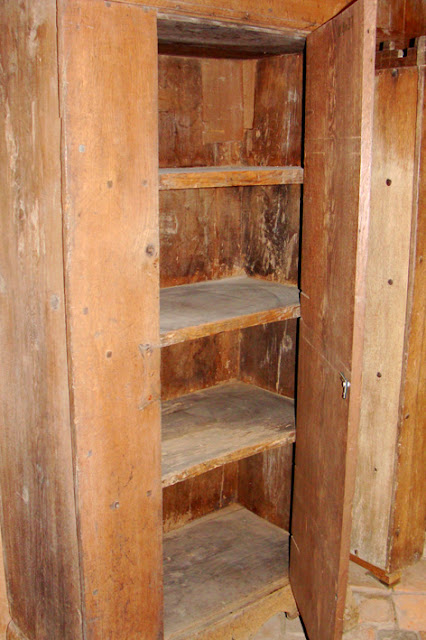To make lasagne take fermented dough and make into as thin a shape as possible. Then divide it into squares of three fingerbreaths per side. Then take salted boiling water and cook those lasagne in it. And when they are fully cooked, add grated cheese. And, if you like, you can also add good powdered spices and powder them onto them, when they are on the trencher. then put on a layer of lasagne and powder [spices] again; and on top another layer and powder, and continue until the trencher or bowl is full. Then eat them by taking them up with a pointed wooden stick.
(Translated from) Libre de coqina, De lasanis f. 412
Medieval lasagne is quite different from that nowadays, although there are some common features. This recipe is relatively easy to make during a re-enactment weekend; the only prerequisite being a large table to roll out the dough. We have made this lasagne at our last weekend at the historic open air museum in Eindhoven and took photos of the whole process. The final result was a very tasty and satisfying meal for children and adults alike. We fully recommend it to others.



14th century medieval lasagne according to the libre de coqina.
Medieval lasagne is quite different from that nowadays, although there are some common features. This recipe is relatively easy to make during a re-enactment weekend; the only prerequisite being a large table to roll out the dough. We have made this lasagne at our last weekend at the historic open air museum in Eindhoven and took photos of the whole process. The final result was a very tasty and satisfying meal for children and adults alike. We fully recommend it to others.
Dough:
3 cups regular flour (no durum flour)
1 cup tepid water
1.5 teaspoon salt
20 gram fresh bakers yeast
Spice mixture:
1/2 teaspoon ground cardamom
1/2 teaspoon freshly grated nutmeg (we used already ground)
1/8 teaspoon freshly ground black pepper
1/8 teaspoon ground cinnamon
Other:
fresh grated Parmesan - we used very old goat cheese instead of the Parmesan
fresh ground black pepper
olive oil
Left: The fermenting dough under a towel in the sun and near the fireplace.
Right: The dough after 1 hour of fermenting and more than doubling in size.
Dissolve the yeast in a little water and after a few minutes mix it into the flour. Add the rest of the water and the salt to form an elastic dough. Knead the dough for some 10 minutes as you would do for bread. The result should be smooth and reveal tiny holes when you cut it with a knife. Cover the dough with a towel and leave to rise in a warm place for about an hour. We placed the bowl with the dough near the camp fire, but not to close.
Left: Grating the old goat cheese with a knife. Right: Getting the dough out on a well floured table.
Grate the cheese and set aside. Grind and mix the spices in a mortar. Towards the end of the rising time bring a large bowl of well salted water to the boil and add a few drops of (olive) oil to prevent the sheets of lasagne sticking to each other. Preheat a baking or gratin dish by filling it with boiling water, but dry it before use. We used a skillet instead, which was placed on a high-legged trivet above the fire just before boiling the lasagne.
Rolling the dough thinly with a wooden rolling pin.

Left: Cutting the lasagne squares with a knife. Right: The lasagne squares, approximately 5 x 5 cm.
Carefully moving the lasagne squares on the flat of the knife to a wooden board, so they can be taken outside to be boiled.
Knead the dough back into a ball and roll it out to an even thickness of about 2 mm. the dough has a tendency to stick, so the workspace and the roller have to be richly floured. Cut the dough into 5 cm squares. Cook the lasagne in the rapidly boiling water and stir with a spoon or skimmer to prevent them from sticking. They are done when they rise to the surface of the water. This will take 2-3 minutes. They should not taste of flour and should be elastic, but not too soft.
Top left: The lasagne boiling in salt water. These pieces are ready. Right: Moving the lasagne pieces to the skillet with help of a skimmer. Bottom left: The lasagne layered with cheese and spices in the warm skillet.
Remove the lasagne with a skimmer and place them in the preheated dish. Sprinkle it with grated cheese, a pinch of the spices and some ground black pepper. Add layers of lasagne, cheese and spices, until you run out of lasagne. Finally, end up with the rest of the cheese and spices. Eat them using a pointed wooden stick.


Left: The finished lasagne on the table, ready to eat. Right: Eating lasagne using pointed wooden sticks.
Also other medieval cookbooks have recipes for lasagne, that can differ in some part, e.g. the use of meat broth or almond milk to cook it, or the omission of yeast fermentation. One such a recipe is found in the Forme of Cureye, translated and modernised in Pleyn Delit - medieval cookery for modern cooks by C.B. Hieatt, B. Hosington and S. Butler, ISBN 08020-06787. The recipe above can also be found (nr. 6) in the modern medieval cookbook: The medieval kitchen - recipes from France and Italy by O. Redon, F. Sabbon and S. Serventi, ISBN 0226706850.























































